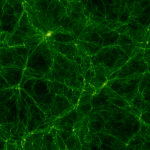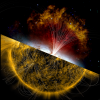Galaxy Lightcones
Diaz-Gimenez+20
These 7 galaxy lightcones are built from the several outputs of the synthetic galaxies provided by different semi-analytic models run on top of the Millennium I, Millennium II and MultiDark dark matter simulations. Galaxies have stellar masses larger than 10^9 Msun for the Millennium I and MultiDark samples, and larger than 10^8 Msun for the Millennium II. These catalogues are all-sky surveys with an apparent magnitude limit that mimics the SDSS observational catalogue (r=17.77).
Download here.
|
VVV Near-Infrared Galaxy Cataloge (VVV NIRGC)
Knowledge about the large-scale distribution of galaxies is far from complete in the Zone of Avoidance, which is mostly due to high interstellar extinction and to source confusion at lower Galactic latitudes. Past near-infrared (NIR) surveys, such as the Two Micron All Sky Survey
(2MASS), have shown the power of probing large-scale structure at these latitudes. Our aim is
to map the galaxy distribution across the Southern Galactic plane using the VISTA Variables
in the Vía Láctea Survey (VVV), which reach 2 to 4 magnitudes deeper than 2MASS. We used SExtractor+PSFEx to identify extended objects and to measure their sizes, the light concentration index, magnitudes, and colours. Morphological and colour constraints and visual inspection were used to confirm galaxies. We present the resultingVVVNIR Galaxy Catalogue
of 5563 visually confirmed galaxies, of which only 45 were previously known. This is the
largest catalogue of galaxies towards the Galactic plane, with 99% of these galaxies being new
discoveries. We found that the galaxy density distribution closely resembled the distribution
of low interstellar extinction of the existing NIR maps. We also present a description of the
185 2MASS extended sources observed in the region, of which 16% of these objects had no previous description, which we have now classified. We conclude that interstellar extinction and stellar density are the main limitations for the detection of background galaxies in the Zone of Avoidance. The VVV NIR Galaxy Catalogue is a new data set providing information for extragalactic studies in the Galactic plane.
Download here.
|
SDSS DR12 Galaxy Group Catalogues
Rodriguez & Merchan+20
Two catalogues of groups identified in the SDSS DR12 and their respective galaxy catalogues are presented. To construct these catalogues, groups were defined as gravitationally bounded galaxies systems with at least one bright galaxy (with an absolute magnitude <-19.5 in the r band). In the FOF_mod catalogues the data that corresponds to the FOF (Friend-of-Friends) identification is presented. It takes into account the aforementioned group definition. In the FINAL catalogues there are groups of galaxies resulting from the complete process: combining the FOF method with a halo-based algorithm. Both group catalogues contain group information which was obtained dynamically and by performing a method of abundance matching in luminosity. Details about these calculations are presented in the corresponding publication.
Download Here |
Seyfert Galaxy Catalog
Schmidt+18
Optical spectra of 28 narrow line Seyfert 1 (NLS1) galaxies covering the spectral range from 4300Å to 5200Å and spectra of 6 NLS1 galaxies in the spectral range 5800Å-6800Å. Data were taken using the CASLEO 2.15m. telescope and using the 600-line/mm grating giving a resolution of 170km/s and 190km/s FWHM around Hα and Hβ, respectively.
|
Compact groups in SDSS DR12
Díaz-Giménez+18
A catalogue of compact groups identified on the SDSS DR12 is provided. Compact Groups were identified in redshift space with a modified Hickson-like algorithm. The catalogue comprises 462 compact groups of which 406 clearly fulfil all the compact group requirements: compactness, isolation and velocity concordance of all of their members. The remaining 56 groups need further redshift information of potentially contaminating sources.
Download Here
|
Extended Objects in the VVV Survey (VISTA Variables in the Milky Way)
Baravalle+18 2018AJ….155…46B
A catalog of 574 candidates for extragalactic sources detected in the VISTA Variables in the Milky Way (VVV) survey is presented, which are obscured by the presence of our Galaxy. This work describes the photometric procedure developed to find and characterize extragalactic objects using a combination of SExtractor and PSFEx in two Tiles of the VVV survey. All candidates were visually inspected, increasing the probability that they are confirmed galaxies. In general, these objects are small and more circular, due to the near-infrared sensitivity to select more compact and brighter superficial objects.
|
Spectral nuclear properties of NLS1 galaxies
Schmidt+16 2016A&A…596A..95S
We present the spectra of 36 narrow-line Seyfert 1 galaxies from the Véron & Véron catalog (Véron – Cetty & Véron 2010) with z < 0.15, brighter than b< 18 and with δ ≤ 10°. Spectra were taken at CASLEO 2.15 m. telescope, with a 600 lines/mm grating giving a resolution of 170 km/s FWHM around Hα. The observations are in the range of 5800Å a 6800Å.
Download. |
Galaxy groups in the 2M++
Díaz-Gimenez E., Zandivarez A. 2015A&A…578A..61D
Díaz-Gimenez+15 present a sample of 813 galaxy groups identified in the 2M++ catalogue is provided. Groups were identified in redshift space with a Friends-of-Friends algorithm with overdensity contour contrast of 433 (present value of the overdenstity contrast contour for virialized structures in a cosmology Lambda CDM - WMAP1). Groups have virial masses larger than 10¹² Msun and 4 or more members. The 4869 member galaxies have observer frame apparent magnitude in the K_2M++ brighter than 12.5
Download Díaz-Gimenez+15.
|
Catálogo de Grupos Compactos en el 2MASX
Díaz-Gimenez+12 2012MNRAS.426..296D
A sample of 85 compact groups with spectroscopic information for all of their member galaxies is extracted from the Two-Micron All Sky Survey extended source catalogue (2MASX). The automatic searching algorithm follows the original criteria defined by Hickson. This v2MCG sample of velocity-filtered CGs constitutes the largest sample of CGs (with N≥4) catalogued to date, with both well-defined selection criteria and velocity filtering, and is the first CG sample selected by stellar mass. It is fairly complete up to Kgroup∼9 and radial velocity of ∼6000km/s.
Download Díaz-Gimenez+12.
|
Galaxy Clusters in SDSS
Coenda+2009. 2009A&A…504..347C
Coenda + 2009 built two subsamples of galaxy clusters with more than 10 members based on two catalogs: ROSAT-SDSS galaxy cluster survey de (Popesso + J/A+A/423/449) and MaxBCG catalogue of(Koester+ J/ApJ/660/239). The two sub-samples of clusters of galaxies was based on a volume limited
sample of galaxies drawn from the spectroscopic DR5 SDSS.
Download Coenda+2009.
Galaxy Clusters in SDSS II
Muriel+2014. 2014A&A…564A..85M
Expanded sample of the sample presented in Coenda+2009, based on the NORAS galaxy cluster survey catalog. I. (Bohringer +, 2000). Similarly, a cluster sample with more than 10 members was built, using a volume limited sample of galaxies drawn from the spectroscopic DR7 SDSS.
Download Muriel+2014. |








